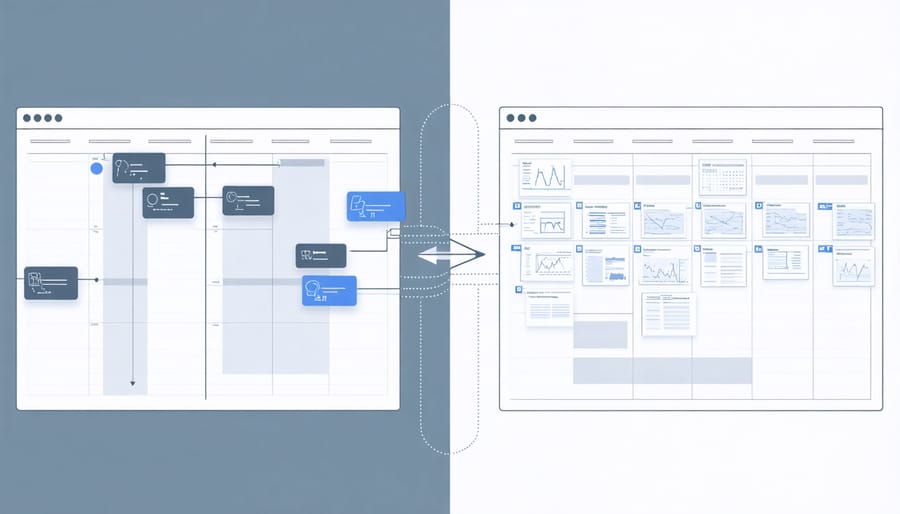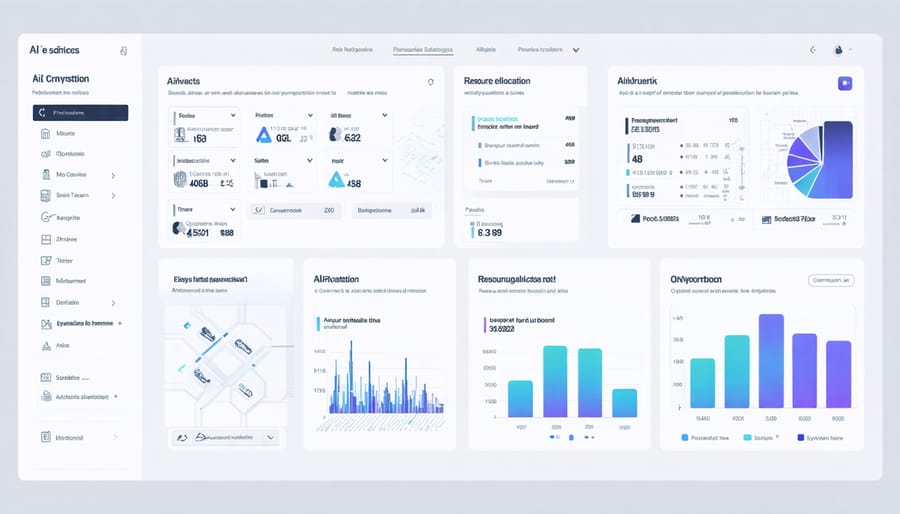Combine traditional Waterfall milestones with Agile sprints to maximize efficiency in large-scale construction projects, leveraging both methodologies’ strengths while mitigating their individual weaknesses. Modern hybrid project management, enhanced by AI’s impact on construction management, delivers unprecedented control over complex building initiatives. Leading construction firms have reported 30% faster project completion and 25% cost reduction by implementing hybrid frameworks that merge detailed long-term planning with flexible, iterative execution cycles.
Major infrastructure projects like the Dubai Metro Extension and Singapore’s Marina Bay development showcase how hybrid methodologies excel in managing multiple stakeholders, complex dependencies, and evolving requirements. These approaches integrate traditional critical path scheduling with Agile’s adaptive planning, enabling real-time adjustments without compromising overall project objectives.
Construction executives implementing hybrid frameworks consistently achieve superior results by maintaining strict quality controls while adapting to site conditions, regulatory changes, and supply chain fluctuations. This balanced approach ensures both predictability and agility, essential elements for modern construction project success.
The Rise of Hybrid Project Management in Modern Construction
Traditional vs. Agile: Finding the Sweet Spot
In construction, finding the optimal balance between traditional and agile methodologies requires understanding where each approach shines. Traditional methods excel in structural aspects of construction, particularly in established project management phases like foundation work, structural engineering, and regulatory compliance. These elements demand rigorous planning, precise execution, and strict adherence to safety protocols.
Agile methods, conversely, prove invaluable in aspects requiring flexibility and rapid adaptation, such as interior design modifications, client feedback integration, and supply chain management. The sweet spot emerges when combining traditional planning for core construction activities with agile principles for client-facing elements and project adaptability.
For example, while maintaining traditional milestone-based scheduling for structural work, teams can implement agile sprint planning for finishing work and client customizations. This hybrid approach allows for both the stability required in construction fundamentals and the adaptability needed to address changing market conditions or client requirements, ultimately delivering projects that meet both technical specifications and evolving stakeholder needs.

AI’s Role in Bridging Methodologies
Artificial Intelligence serves as a crucial bridge between traditional and agile project management methodologies in modern construction projects. AI-powered platforms analyze historical project data to identify optimal combinations of methodologies for specific project phases. These systems can automatically adjust workflows, resource allocation, and scheduling based on real-time project conditions and requirements.
For example, AI algorithms can determine when to apply waterfall-style planning for foundation work while simultaneously supporting agile sprints for interior finishing tasks. Machine learning models assess project parameters, team capabilities, and risk factors to recommend the most effective hybrid approach for each project component.
Predictive analytics capabilities enable project managers to anticipate bottlenecks and conflicts between different methodologies, allowing for proactive adjustments. AI-driven dashboards provide unified views of both traditional and agile metrics, ensuring comprehensive project oversight. Natural language processing facilitates communication between teams using different methodologies, automatically translating requirements and updates into appropriate formats for each team’s preferred framework.
This technological foundation helps organizations maintain consistency and control while embracing the flexibility needed in modern construction projects.
Real-World Implementation Examples

High-Rise Development Case Study
The Skyline Tower project in Singapore demonstrates how hybrid project management effectively combines traditional and agile methodologies in high-rise construction. This 45-story mixed-use development successfully integrated waterfall planning for structural elements with agile sprints for interior finishing and technological installations.
The construction team employed traditional waterfall methodology for foundation work, core structure, and essential building systems, ensuring strict compliance with safety regulations and engineering specifications. This phase followed a linear progression with detailed milestone planning and rigid quality control protocols.
Simultaneously, agile principles were applied to interior fit-outs and smart building system installations. Two-week sprints allowed for rapid prototyping of apartment layouts and flexible adaptation to changing market demands. Daily stand-ups between contractors and subcontractors facilitated quick problem-solving and resource reallocation.
The hybrid approach yielded impressive results: completion three months ahead of schedule and 12% under budget. Key success factors included:
– Clear delineation between waterfall and agile components
– Digital collaboration platforms for real-time progress tracking
– Regular stakeholder feedback integration
– Adaptive planning for non-structural elements
The project team utilized BIM technology alongside traditional construction documentation, enabling better coordination between traditional and agile work streams. This case study highlights how hybrid methodologies can optimize large-scale construction projects while maintaining essential quality and safety standards.
Infrastructure Project Implementation
Infrastructure projects have witnessed remarkable improvements through the implementation of hybrid project management approaches. A notable example is the Sydney Metro expansion project, which successfully combined traditional waterfall methods for structural engineering with agile sprints for systems integration and technological components. This hybrid approach resulted in a 23% reduction in project timeline and improved stakeholder communication.
The key to success lies in strategically dividing infrastructure projects into distinct components. Core construction activities, such as foundation work and structural elements, follow traditional methodologies with detailed planning and sequential execution. Meanwhile, technological integrations, environmental monitoring systems, and resource allocation are managed through agile frameworks, allowing for rapid adjustments and continuous improvement.
The Denver International Airport’s terminal renovation project exemplifies this approach. The project team utilized traditional methods for structural modifications while implementing agile practices for systems upgrades and passenger flow optimization. This hybrid strategy enabled continuous terminal operations during construction while maintaining flexibility for design improvements.
Critical success factors include:
– Clear delineation between traditional and agile components
– Integrated digital platforms for cross-team collaboration
– Regular synchronization meetings between traditional and agile teams
– Risk management frameworks that accommodate both methodologies
– Flexible resource allocation based on project phase requirements
This balanced approach has proven particularly effective in large-scale infrastructure projects where complexity demands both structured planning and adaptability to changing conditions.
Renovation Project Success Story
The Metropolitan Hotel renovation project in downtown Chicago exemplifies how hybrid project management can successfully navigate complex construction challenges. The $45 million renovation combined traditional waterfall planning for structural modifications with agile methodologies for interior design and finishing work, resulting in a 15% reduction in project timeline and significant cost savings.
The project team implemented a three-tier approach: structural work followed strict sequential planning with detailed milestone tracking, while interior design and FF&E installation utilized two-week sprints with daily stand-ups. Technology integration and mechanical systems upgrades were managed through a hybrid kanban system, allowing for simultaneous progress across multiple floors while maintaining critical path dependencies.
Key success factors included:
– Daily digital documentation and progress tracking
– Bi-weekly stakeholder reviews combining traditional reporting with sprint retrospectives
– Flexible resource allocation between traditional and agile teams
– Real-time issue resolution through a centralized project dashboard
The renovation team particularly benefited from this approach during unexpected challenges, such as discovering historic architectural elements that required preservation. The agile component allowed for quick adaptation of design elements while maintaining the overall structural modification schedule. This hybrid approach enabled the project to complete three weeks ahead of schedule while accommodating 23 major change orders without disrupting the critical path.
The project’s success has since become a blueprint for similar large-scale renovation works, demonstrating how traditional construction management can effectively integrate agile principles to enhance project outcomes.
AI Tools Enabling Hybrid Management
Predictive Analytics for Resource Allocation
Modern construction projects benefit significantly from AI-powered project management tools that leverage predictive analytics for optimal resource allocation. These systems analyze historical project data, real-time progress metrics, and external factors to forecast resource requirements across different project phases.
By implementing machine learning algorithms, project managers can now predict labor needs, equipment utilization, and material requirements with unprecedented accuracy. For example, on large-scale commercial developments, AI systems can analyze weather patterns, supplier delivery schedules, and workforce availability to recommend optimal resource distribution schedules weeks in advance.
The predictive capabilities extend to risk assessment, enabling teams to identify potential resource bottlenecks before they impact project timelines. Advanced algorithms calculate resource utilization rates and suggest reallocation strategies based on project priorities and constraints. This proactive approach has shown to reduce resource-related delays by up to 30% in pilot programs across major construction firms.
Key benefits include:
– Dynamic workforce scheduling based on skill requirements and availability
– Automated equipment allocation optimization
– Real-time material requirement forecasting
– Prevention of resource conflicts between concurrent project phases
– Cost optimization through efficient resource distribution
These predictive systems integrate seamlessly with traditional project management methodologies while incorporating agile principles for rapid response to changing conditions, creating a truly hybrid approach to resource management in construction projects.

Real-time Progress Monitoring Systems
Modern construction projects benefit significantly from AI-powered progress monitoring systems that provide real-time insights and data-driven decision support. These sophisticated tools combine computer vision, IoT sensors, and machine learning algorithms to track project milestones, resource utilization, and schedule adherence with unprecedented accuracy.
Leading construction firms are implementing systems that use drone imagery and LiDAR scanning to create digital twins of construction sites, enabling project managers to compare actual progress against BIM models automatically. These platforms can detect schedule variances, safety concerns, and quality issues before they become critical problems.
For example, major contractors are utilizing AI-powered platforms that analyze construction site camera feeds to track worker productivity, equipment usage, and material placement. These systems automatically update project dashboards and send alerts when deviations from planned schedules occur, allowing for immediate corrective action.
The integration of smart sensors throughout construction sites provides continuous monitoring of environmental conditions, structural integrity, and resource consumption. This data feeds into centralized project management platforms, offering predictive analytics and enabling proactive risk management.
Real-time monitoring systems also facilitate better collaboration between office and field teams by providing a single source of truth for project status. Project stakeholders can access current information through mobile applications, making informed decisions based on accurate, up-to-the-minute data rather than outdated reports or manual observations.
Implementation Strategies and Best Practices
Team Structure and Training
In successful hybrid project management implementations, team structure plays a pivotal role in bridging traditional and agile methodologies. Construction organizations typically establish cross-functional teams that combine specialists from different disciplines, including project managers, architects, engineers, and field supervisors. These teams are organized into core units that handle traditional waterfall processes for regulatory compliance and structural planning, while agile sub-teams manage iterative aspects like interior design modifications and client feedback integration.
Training programs focus on developing dual competencies in both methodologies. Team members receive instruction in traditional project management fundamentals, including critical path scheduling and risk management, while simultaneously building expertise in agile practices such as daily stand-ups and sprint planning. This dual-track approach ensures teams can seamlessly transition between methodologies as project phases demand.
Leadership roles often include a traditional project manager who oversees overall project governance and an agile coach who facilitates adaptive planning and continuous improvement. Regular cross-training sessions help team members understand both perspectives, fostering better collaboration and communication. Organizations typically implement mentoring programs where experienced hybrid project managers guide newer team members through the complexities of managing dual methodologies.
Technology training is equally important, with teams learning to use integrated project management platforms that support both traditional Gantt charts and agile boards. This technological proficiency enables efficient workflow management and real-time project tracking across both methodologies.
Technology Integration Framework
Implementing AI tools in hybrid project management requires a systematic approach that aligns with existing resource optimization strategies. Begin by conducting a thorough assessment of your current project management processes to identify areas where AI can add the most value. Focus on establishing a clear data infrastructure that can support AI integration, ensuring all project data is digitized and properly structured.
Next, implement AI tools incrementally, starting with specific use cases such as predictive analytics for risk assessment or automated progress tracking. Select AI solutions that offer APIs and integration capabilities with your existing project management software. Train your team on the new tools and establish standard operating procedures that combine traditional methodologies with AI-enhanced processes.
Monitor and measure the impact of AI implementation through key performance indicators (KPIs) such as schedule adherence, cost savings, and resource utilization. Regularly collect feedback from team members and stakeholders to refine the integration process. Create documentation that clearly outlines how AI tools supplement existing project management frameworks and when to rely on human judgment versus automated solutions.
Finally, establish a continuous improvement cycle that evaluates new AI capabilities and adjusts the integration framework based on project outcomes and emerging technologies. This ensures your hybrid approach remains effective and adaptable to changing project requirements.
The integration of AI-driven hybrid project management approaches in construction has demonstrated significant potential for improving project outcomes. By combining traditional methodologies with agile principles and AI capabilities, organizations are experiencing enhanced efficiency, reduced risks, and better resource allocation. The future outlook appears promising, with emerging technologies like machine learning and predictive analytics poised to further revolutionize construction project management. As the industry continues to digitize, we can expect to see more sophisticated AI applications supporting hybrid frameworks, enabling real-time decision-making and automated workflow optimization. Construction firms that embrace these innovative approaches while maintaining flexibility in their methodology selection will be better positioned to meet evolving project demands and maintain competitive advantage in an increasingly technology-driven sector.

